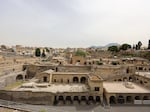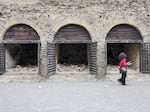
A general view of the the archaeological excavations of Herculaneum in southern Italy.
Marco Cantile / LightRocket via Getty Images
Big news for history buffs and the morbidly curious: An ancient Roman beach is now open to the public for the first time since it was destroyed by the eruption of Mount Vesuvius in 79 AD.
The beach at the Herculaneum archaeological park, located in the southern Italian region of Campania, opened on Wednesday after a multi-year restoration project.
"Today, after three years of intensive work aimed at the enhancement of the ancient beach of the Herculaneum excavations, by draining and filling the area formerly occupied by the sandy shore, visitors are given free access over the entire area and an understanding of the dynamics that led to the burial of the city," said Carabinieri Brigadier General Giovanni Capasso, who oversees the Great Pompeii Unit.
Herculaneum — named for the Greek god Hercules — is believed to have been founded by the Oscans in the 7th century BC and dominated by Rome in 90 BC. Its location on Italy's west coast and mild climate made it a popular resort town for Rome's patrician families.
It was much smaller (both demographically and geographically) than the city of Pompeii, about 10 miles to the south. Both were destroyed in the eruption of Mount Vesuvius, buried by clouds of ash and volcanic debris that preserved them in place for centuries.
Herculaneum lay buried longer, beneath some 50 meters of ash, until it was discovered by accident in 1709 as a worker drilled a well for a monastery.
A series of excavations of the site during the 18th and 19th centuries uncovered parts of buildings, ornate works of art, papyrus scrolls and other artifacts.
But archaeologists found few human remains in Herculaneum, unlike the perfectly preserved casts of bodies at Pompeii. That led them to believe that most of the city's inhabitants had been able to escape the volcano's wrath in the direction of Naples.
Subsequent digs in the 1980s and '90s, however, uncovered the skeletons of more than 300 people in stone boathouses near the beach.
Researchers now believe that they died from the heat as they waited in vain to be rescued by Pliny the Elder, a Roman statesman who died while attempting to save civilians by boat. One 2020 study suggests the heat from the eruption was so intense that it turned one victim's brain into glass.

A view of the skeletons of the fugitive victims of the eruption of Vesuvius in 79 AD on the ancient beach, open to the public for the first time, in the archaeological excavations of Herculaneum.
Marco Cantile / LightRocket via Getty Images
The human remains hold clues for researchers about how inhabitants of Herculaneum both lived and died.
One famous skeleton, for example, is referred to as the "Ringed Lady," because of the emerald and ruby rings sparkling on her finger. Another, first discovered in the 1980s near the remains of a boat, is now thought to belong to a senior Roman soldier likely sent on a rescue mission, based on his belt and weapons.
And in their most recent dig in 2021, archaeologists uncovered the remains and personal belongings of a man they are calling "the last fugitive." The black and reddish bones (stained by blood, experts say) of a man believed to be between 40 and 45 years old were found just steps away from the shoreline.
He was clutching a satchel. Inside was a wooden box containing a ring, made of iron or bronze.
"He was possibly escaping with his treasures," conservator Nunzia Laino told The Guardian at the time.
The boathouses, with their arched entryways and skeleton replicas, are still visible at the beach.
Park director Francesco Sirano said in a news release that the conservation work aimed to reduce the risk of flooding, restore the original level of the beach and bring back sand, to "let everyone walk on the beach again."
"If we turn our heads to where the sea once was, we become modern explorers of the immense blanket of volcanic flows that covered the city in a few hours," he added. "And we cannot help ourselves from sharing almost the sense of total annihilation of our human condition in the face of the evidence of [the] cataclysm of 79 AD."
The beach area is one of multiple sites visitors can explore at Herculaneum. Other popular attractions open to the public include well-preserved baths, an underground theater and luxurious residences with elaborate mosaics.
Copyright 2024 NPR